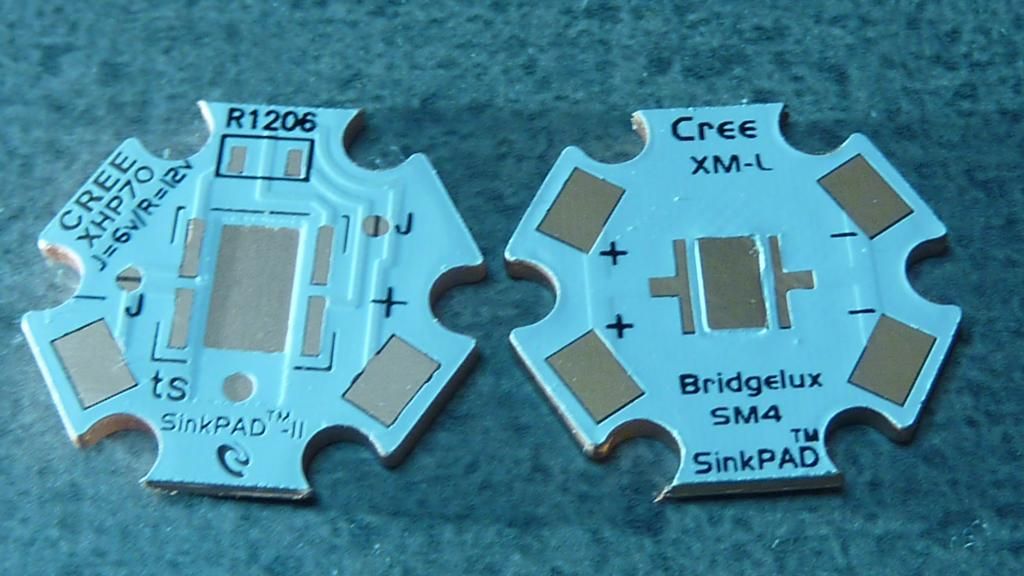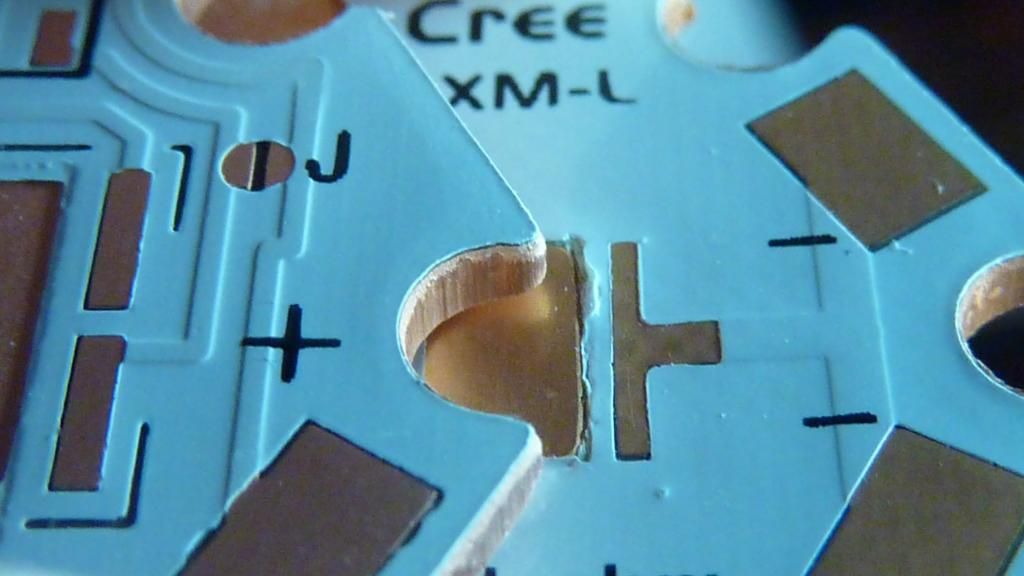…ahem…maybe this is why they’re so eager to give out free samples of these pcbs ![]() :bigsmile:
:bigsmile:
I think we should give them a heads up on the issue. Not as wild a eyed performance enthusiast, but in a professional manner. If done correctly it could lead to considerations for other free samples in the future
The 12V option pads are designed that way for users other than flashlight people. If you want 6V application you need to ask for the correct star. They’re not mind readers. Asking for the XHP70 star is misleading, do the research and find what is applicable to the situation at hand and ask for the correct part. In this case, that would be the copper MK-R star.
SinkPAD does much more than keep hobbyists happy with their toys.
‘issue’…. ?
I find it very difficult to believe that they are not aware of the repercussions of their design decisions.
Well sure, but stepping down from a big pad to a tiny trace right away even when you have plenty of space to leave much more copper is surely not a well thought out design.
That’s a bad or an inadequate design if you ask me, even if the maximum datasheet current @ 6v is “only” 4.8A.
Especially when the goal of all of this is to maximize efficiency in high power leds through perfect cooling (not even talking about flashlight use here), silly to incur other losses in something as simple as circuitry.
Well sure, but stepping down from a big pad to a tiny trace right away even when you have plenty of space to leave much more copper is surely not a well thought out design.
That’s a bad or an inadequate design if you ask me, even if the maximum datasheet current @ 6v is “only” 4.8A.Especially when the goal of all of this is to maximize efficiency in high power leds through perfect cooling (not talking about flashlight use here), silly to incur other losses in something as simple as circuitry.
The thin trace is almost certainly there in order to help with soldering.
EDIT: and no-one is going to use the 6v/12v boards as 6v boards in production. There is absolutely no reason to do it (MK-R boards are better…) and the solder jumpers are just a no-no. The large 1206 jumper is required for 12v operation with or without a 6v option, so that has to be on the board anyway and is easily handled during production. Think of the 6v operation of these 6v/12v boards as an added bonus for engineers doing prototyping. 6v operation on the 6v/12v board is merely an afterthought or a bonus.
EDIT: and no-one is going to use the 6v/12v boards as 6v boards in production. There is absolutely no reason to do it (MK-R boards are better…) and the solder jumpers are just a no-no. The large 1206 jumper is required for 12v operation with or without a 6v option, so that has to be on the board anyway and is easily handled during production. Think of the 6v operation of these 6v/12v boards as an added bonus for engineers doing prototyping. 6v operation on the 6v/12v board is merely an afterthought or a bonus.
Yeah ok I can see that.
Still don’t really see why a narrow trace width will help in soldering on a copper core pcb but you’re right that there are production considerations that don’t often make a lot of sense at first glance.
Well, it’s already trickier to solder onto an MCPB than a regular PCB. In our hypothetical production scenario we’re definitely going to have air wires to connect the already-reflowed MCPCBs to stuff (that’s the only way to make use of these MCPCBs after all). Soldering wires onto MCPCBs is already trickier than soldering wires onto other things, and these MCPCBs will probably also be bolted onto heatsinks before the soldering happens. The dielectric layer is our only saving grace! Now imagine that we increase the coverage of the +/- pads (basically turn traces into pours). This will improve the flow of heat from those pads through the dielectric. (As well as to the the LED and thus eventually through the DTP connection!)
That’s all a bad thing when we’re trying to assemble stuff. We really need the thermal path away from any soldered connections to be poor in order to make soldering easy.
… So I assume that’s why skinny traces were used.
If the whole idea behind a SinkP,ad is to help dissipate heat generated by the LED, why introduce the added heat generated by the small traces. That should strike a nerve with them.
What they have done is contrary to the philosophy of SinkPad.
That is the tact I would use.
If the whole idea behind a SinkP,ad is to help dissipate heat generated by the LED, why introduce the added heat generated by the small traces. That should strike a nerve with them.
What they have done is contrary to the philosophy of SinkPad.
That is the tact I would use.
It should strike a nerve if they were lazy about it, but as Wight points out they might have done the best they could given the production requirements and restraints.
I’m just more prone to thinking that Wight in posting that reply has actually put more thought into the specific production concerns and justifications for skinny traces than Sinkpad did.
All good valid points btw, but I still don’t entirely buy it. ![]()
![]()
-
In any case I hate to rag on about a company’s product, especially after them being nice enough to supply us with free samples. Just want to remain objective and see these for what they are; 12v pcbs with limited appeal to us 6v high amp enthusiasts.
Well I'll be damned. I ordered the 6V sinkpads. Now I feel better and foolish at the same time.
SinkPad is selling performance, pure and simple. That is what differentiates them from other manufacturers. I can see that we members here might have a more difficult time with soldering larger pads with thicker traces. I don’t see that with production facilities. If that were a problem maybe they should use Aluminum instead.
If SinkPad purposefully chose to use thin traces to make soldering easier, can you see a competitor extolling the performance virtues in their use of thicker traces thereby giving their product a performance advantage over SinkPad?
I almost think of these samples as a Beta release and us free recipients as Beta testers. If that is true, then we have a duty to communicate our opinions to them.


It all looks very purposeful to me, including from the detailed pictures you show. There’s no reason to create a “beta” with something like this… I don’t think you’ve really stepped all the way through that line of thinking. It appears that the SinkPAD layout goes to great pains to maximize clearance between the traces. (Also note that the “maximum drive current” for a 12v XHP70 is lower than the “maximum drive current” for an XM-L2.)
I also think that you haven’t given enough consideration to the production line / QA issues caused by difficult soldering requirements.
I can see a competitor bragging about differences as “advantages”, this is a normal thing in almost all marketplaces. Tell me that you have not laughed at product descriptions doing just that?
If SinkPAD was purely performance oriented their existing product line would be different. They already have much thinner LED traces than Noctigon for all existing products. Why do you think that is the case? Noctigon sells a purely enthusiast targeted product. SinkPAD does not.
I’m not trying to recommend that you do not communicate your opinions to SinkPAD. I personally find it rather obvious that this is “as good as it gets” for the 12v DTP product from SinkPAD.
wight, you may very well be right in all you say. Who am I to actually know what they are thinking. But to me it is just a shame that with all the copper and all the potential of the XHP70, that the bottleneck could be the traces on this SinkPad.
I suppose that thought is coloring my reasoning.
I do know this, that very few engineers are allowed to design for absolute maximum performance. There are always other factors to consider.
Meh, no big deal. As LinusHofmann commented earlier, it is possible that I’ve put more thought into retroactively explaining their design choices than they did in making them. (I do still think they were all fairly well grounded choices.)
The real issue here is more that Cree laid out the XHP emitters in this fashion! MK-R emitters and other HV Cree emitters allow for much easier wiring at 12v+. I wonder if we’ll see additional variants of the XHP emitters (with different electrical requirements) as Cree feels out the market for these?
It's never going to happen, but a 3V version with all four in parallel would be sweet. 
Is it me or are the traces on the 12v twice as thick as well as half as wide, if so they will both have the same resistance and carry the same current.
Of course it could just be camera angles or the fact that I got no sleep last night ![]()
Cheers David
Is it me or are the traces on the 12v twice as thick as well as half as wide, if so they will both have the same resistance and carry the same current.
Of course it could just be camera angles or the fact that I got no sleep last nightCheers David
I think that’s a fair question! That said, notice that the comparison pics dchomak posted above are a 12v XHP70 SinkPAD II vs an oldschool SinkPAD (as in the “I” version, original version). Besides stopping punching the middle of the MCPCB I don’t know what other differences there are between the two lines. Maybe nothing, but for really even footing it might be best to compare SinkPAD II with SinkPAD II.
It’s never going to happen, but a 3V version with all four in parallel would be sweet.
+1
Please CREE make this :_( i want a single battery option on your XPH’s